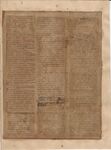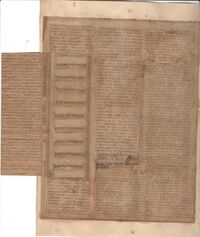
Legend
< Изъ-за Океана (continued from page 4-40) >

манiя.“ Хоръ и органъ заглушили дальнҍйшiя восклицанiя и порядокъ мало по малу водворился.
Полков. Олькоттъ подошелъ къ пюпитру. Не возмучеиотимо выждавъ, чтобъ воцарилось полнҍйшее молчанiе, звучнымъ, прiятнымъ голосомъ началъ говорить. Онъ далъ отчетъ въ происхожденiи и задачахъ өеозофическаго общества; объяснилъ его цҍль: изученiе психологическихъ силъ человҍка и влiянiя ихъ на законы природы. Онъ разсказалъ какъ покойный баронъ, бывъ съ молоду человҍкомъ тщеславнымъ, избалованнымъ (и высокимъ положенiемъ своимъ и большимъ состоянiемъ) придворнымъ, съ годами началъ смотреть серьезнҍй на жизнь и ея значенiе; началъ ревностно искать истиннаго смысла ея и въ наукҍ и въ религiяхъ и нигде не находилъ удовлетворенiя своимъ вопросамъ и требованiям. Наконецъ усталый онъ покинулъ Европу и поселился на сҍверо-западҍ Америки, надҍясь найти отдохновенiе и нравственное спокойствiе въ общенiи съ полудикими индiцами. Но и тутъ желанiе найти истину не оставляло его. Онъ случайно попалъ въ общество нҍсколькихъ спиритовъ и обратился къ нимъ въ надеждҍ найти въ ихъ ученiи ту истину, которую напрасно искалъ въ церквахъ всҍхъ вероисповҍданiй. „Онъ не ошибся въ своей надеждҍ. Не довольствуясь тҍмъ, что, присутствуя на сеансахъ нашихъ, онъ сталъ очевидцемъ явленiй, съ-разу разсҍявшихъ сомнҍнiя его въ продолженiи жизни нашей за гробомъ, баронъ де Пальмъ желалъ узнать законы, силой которыхъ эти явленiя производились. Съ этой цҍлью онъ вступилъ членомъ въ наше өеозофическое общество и много разъ потомъ выражалъ свою радость о томъ, что попалъ, наконецъ, на истинный путь, осмыслившiй въ глазахъ его все значенiе человҍческой жизни и озарившiй яркимъ свҍтомъ будущность, закрытую доселҍ темной завҍсой смерти“...
Далҍе полк. Олькоттъ вдается въ разборъ несостоятельности христiанскаго обряда отпушенiя грҍховъ умершимъ, выражая увҍренность, что никакiя моленiя, ни церковныя торжества не иcкупятъ преступленiй нашихъ, что грҍшникъ и праведникъ равно должны пожать въ будущей жизни то, что посҍяли въ здҍшней, и могутъ уповать лишь на милосердiе Единаго Творца, имущаго власть отпускать прегрҍшенiя. Онъ очень вҍско распространился о злоупотребленiяхъ духовенства этимъ и многими другими правами и нҍсколько разъ долженъ былъ усмирять взрывы аплодисментовъ, заглушавшихъ его рҍчь. Онъ заключилъ ее слҍдующими словами:
„Если умершiй другъ нашъ велъ жизнь чистую, если онъ достойно развивалъ ввҍренныя ему Творцомъ дарованiя – порадуемся, что нынҍ ему будетъ воздано по заслугамъ. Если-же нҍтъ – то никакое желанiе наше не облегчитъ его состоянiя: не въ нашей власти отпустить ему ни iоты изъ прошлыхъ дҍяний его. Онъ вҍдалъ, что творилъ, ибо былъ убҍжденъ, вмҍстҍ съ нами, въ истинҍ Аристофанова возгласа, столь часто принимаемаго людьми за парадоксъ: „Не жить – есть жить!“ Возгласъ, перефразированный еще яснҍе Фриксасомъ: „Умереть – есть ожить!“
Такъ какъ въ то время въ Америкҍ не существовало еще крематорiи (газовой печи для сожиганiя труповъ), то тҍло барона де Пальма было набальзамировано и временно опущено въ склепъ, при лютеранской церкви. Черезъ шесть же мҍсяцевъ, въ декабре прошлаго года, таковая была окончена въ Вашингтонҍ (докторомъ Ж. Лемуаном): она обошлась строителямъ въ 20,000 долларовъ, и трупъ барона де Пальма былъ первымъ въ ней сожженъ. При депутацiи отъ өеозофическаго общества (turn leaflet).
общества и ... изо всҍх штатов многихъ ученыхъ докторовъ,
New York, 29 May 1876 (Νεα Υορκη Μαίον 29 1876)
In my last letter, I wrote that Mr. Olcott sent me an invitation, so that I could attend the funeral of Baron de Palm, member of the Theosophical Society, which has Mr. Olcott as its President. The invitation was printed in silver on black paper with triangular shape. It referred to the death of Josef, Ludvich, Henry, Charles, Baron de Palm, Great Cross of the Holy Sepulchre, Knight of Saint John of Meliti, Prince of the Roman Empire, ex Valet of his Majesty the King of Bavaria, etc., etc., will have his funeral in the Masonic Temple, on May 28, at 4.00 pm. Half an hour before that time I had occupied my chair in the grand hall of the said building.
Almost all local newspapers trumpeted forth that the ceremony will take place as in very ancient Egypt. Due to this, many people were curious and they were pushing at the windows of the Masonic building, waiting with anxiety to see the dead person being carried on the shoulders of Egyptian hierophants and accompanied by half naked Ethiopian women, who were mourning the deceased, while friends and relatives were calling loudly his virtues and various other actions that were customary by the ancient Egyptians. Many expected that perhaps the burial procession was going to pass through the city streets and when arriving by the lake in Central Park, the death bed would be put on the ground and the herald would call upon those present to pass judgment on the dead person. Unfortunately none came in sight, to the great disappointment of the curious. The ceremony was conducted with great simplicity and dignity inside the building, while a small musical instrument was playing.
In the middle of the room an altar was erected and a wooden cross was standing on it, with a snake winding around it, and that was symbolic, according to a member of the Society, of “the evolution of matter”. On the other side of the cross, in a large pot, a fire was blazing, symbolizing the fire-worship of the ancients. Between the cross and the fire pot the death bed was placed. The coffin was made of ebony wood, decorated with silver and gold nails and handles, and an inscription was attached of the name, the age and the titles of the dead person. On the coffin were burning seven candles, five of which were white, one was red and another green and these were symbolic of the fire-worship and the worship of the light.
In a circle around the coffin, the President and six members of the Society sat, wearing long cloaks of black color. All of them held in their hands green leaves symbolizing “peace and friendship to all mankind”. The chamber was full of selected people, amongst them were several ladies. Unfortunately, the funereal silence that prevails during such ceremonies, was absent at this chamber. Due to the whispering, laughing and other noises, the President and Hierophant had to remind those present that the dead person was amongst them and he requested that the audience attend the ceremony in silence. After the short speech a small chorus of men and women chanted a hymn, supposed to be Orphic, which nobody understood.
Then a Mr. Thomson recited a prayer, at the end of which the chorus repeated Amen four times. The prayer was as follows: “Oh Spirit of Light and Wisdom! The world’s soul, which gives and alters the shape of any object! Earth unveils you and renders you visible by all. In your presence, life is a shadow that changes, or steam that passes away, infinite and unending motion in an eternal constancy. Send to us a small ray of your intelligence. And the mobile will be transformed to solid and compact, the shadow to a body, the dream to an idea of the unending breath of life, oh mouth that gives and receives all beings, supervise and bless our works! Amen! Amen! Amen! Amen!
Many laughed, others simply smiled, some shrunk their shoulders and others were praying <... continues on page 4-42 >
Editor's notes
- ↑ New York, 29 May 1876 (Νεα Υορκη Μαίον 29 1876) by unknown author, In Athens (Αθηνησι). Original text in Greek
